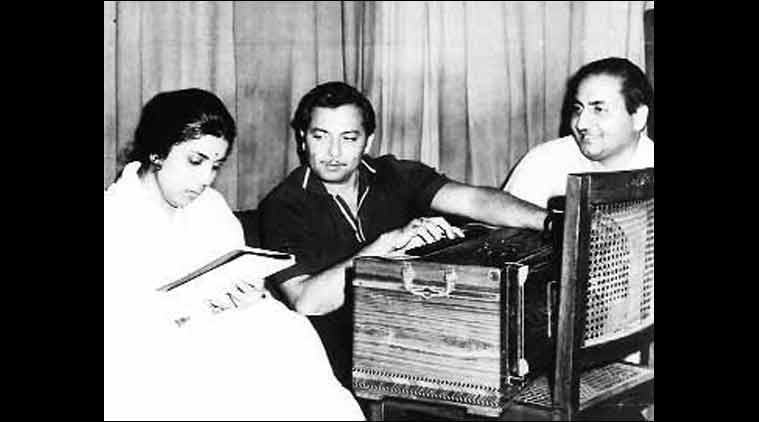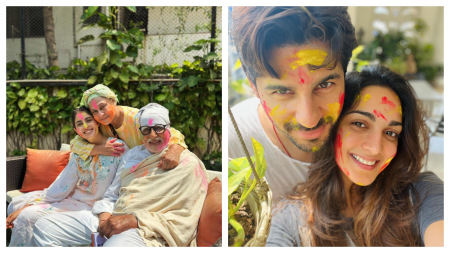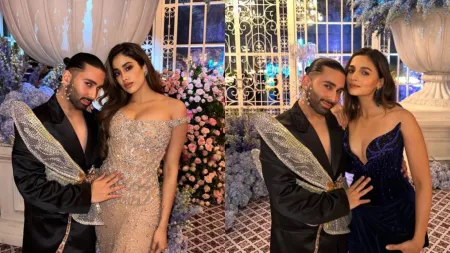- India
- International
The Other Lata
The reclusive Suman Kalyanpur, the voice that was often mistaken to be that of Lata Mangeshkar, looks back at an almost-famous life
 Down melody lane Suman Kalyanpur (top); with music director Madan Mohan (centre) and singer Mohammad Rafi.
Down melody lane Suman Kalyanpur (top); with music director Madan Mohan (centre) and singer Mohammad Rafi.
When Kalyanji Anandji were composing the song Na na karte pyar tumhi se kar baithe, they perhaps never thought it would become as popular as it eventually did. The upbeat structure of the song from Jab Jab Phool Khile (1965), which incorporated a unique theka on the dholak, was markedly different from the intricate, raga-based songs that had been heard in the last two decades. Lata Mangeshkar, many people thought, had woven her magic once again. So in the late ’80s, when Doordarshan, in its famous show, Chhaya Geet, attributed the song to singers Lata Mangeshkar and Mohammad Rafi, no one batted an eyelid, except a 20-year-old girl named Charul. She called up the Prasar Bharati office and requested them to ratify the error. The female singer was her mother Suman Kalyanpur. “No one believed me. It sounded exactly like Lataji’s,” says Charul Hemmady.
Aaj kal tere mere pyaar ke charche (Bramhachari, 1969), one of Kalyanpur’s well-known duets with Rafi, met the same fate. “Even many Lata acolytes couldn’t make out the difference,” says senior music critic Raju Bharatan. The reticent singer made an appearance after more than two decades and hummed the same song at a recent function at Delhi’s Kamani auditorium that was organised by the Maharashtra government in her honour.
Kalyanpur looks uncomfortable when asked about the similarity between her voice and Lata’s, but she answers carefully. “I was quite influenced by her. In my college days, I used to sing her songs. Meri aawaaz nazuk aur patli thi (My voice was fragile and thin). What could I do? Also when Radio Ceylon relayed the songs, the names were never announced. Even the records sometimes gave the wrong name. Maybe that caused more confusion. Shreya Ghoshal’s voice is also thin, but can people go wrong now? We were living in different times then,” says the soft-spoken Kalyanpur, 78, who rarely agrees to giving interviews. Veteran radio artiste Ameen Sayani had to chase her for close to 45 years before he could record a one-hour show with her in 2005. “She spoke so little. As much as I would try, she answered a lot of questions in monosyllables,” says Sayani. After repeated requests, she agrees to meet us, but with certain conditions. “No photoshoot. Uncomfortable questions may not be answered.” We agree.
On the third floor of her Lokhandwala apartment in Mumbai, next to her daughter’s house, where she lives alone now, Kalyanpur greets us with a nervous smile. A landscape Kalyanpur painted hangs on the wall. “This is what I do these days. I paint. Cooking is another favourite. Bas issi sab mein din beet jaata hai (The day goes by in all this),” she says. And what about the riyaaz that playback singers swear by? “Kabhi kabhi gunguna leti hoon kuch (Sometimes I hum something). I haven’t been singing for a very long time,” says Kalyanpur, who is remembered for being a “shy girl whose voice had shehed jaisi mithhas (the sweetness of honey)”.
In the 1950s and ’60s, the music industry moved to a different beat and the period was later referred as the golden era of Hindi film music. This was also the time when female playback singing was dominated by the Mangeshkar sisters, more Lata than Asha (Bhosle). “Suman naturally sounded like Lata. She was diligent, sharp and had a lovely voice. So when Lata was unavailable, or if the producers could not afford her rate of Rs 100 per song, or if the song suffered because of her refusal to sing with Rafi over royalty issues, Suman, the poor man’s Lata, was called in. She was a great substitute,” says Bharatan.

Kalyanpur sang two duets with Lata before her own songs became popular. Kabhi aaj kabhi kal in the Balraj Sahni-starrer Chand (1959) was a Hemant Kumar composition. “We (Lata and I) were quite cordial to each other and felt like friends. I always felt that there was a lot to talk,” says Kalyanpur, going quiet for almost a minute. Her daughter adds, “That’s how you feel. What about her (Lata)?” Ignoring the remark, Kalyanpur says, “I was invited for Lekin’s premiere and that was the last time I met her.” As rumours had it, Lata would sometimes refuse to sing with composers who chose Kalyanpur, and they couldn’t afford to upset Lata.
Kalyanpur grew up in a conservative family in Mumbai and was the eldest of five sisters. She had no formal training and sang at home. “Ma and pitaji used to love bhajans. But we were not allowed to sing outside,” says Kalyanpur. Then Suman Hemmady, she sang in the public for the first time at a neighbouring Ganpati Mahotsav, but it was family friend DB Jog’s Marathi film in 1953 that got her inside a recording studio for the first time. “My father agreed, but he accompanied me to every recording,” says Kalyanpur.
She was 16 and a student at JJ School of Art when singer Talat Mehmood heard her sing at a college function and “gave a lot of shabaashi”. He then put her in touch with recording company HMV. Though HMV producers found her voice “amateurish”, Kalyanpur got a song in Darwaaza (1954) and debuted with Talat (Ek dil, do hain talabgaar). The song made the film industry sit up and notice. This was followed by Chhodo chhodo mori baiyaan (Miya Bibi Raazi, 1960), Na tum humein jaano (Baat Ek Raat Ki, 1962), Mere sang ga (Janwar, 1965), Aajhuna aaye baalma (Saanjh aur Savera, 1963), Tumne pukaara aur hum chale aaye (Rajkumar, 1964) and several others.
After her marriage in 1958, her husband accompanied her for every recording session. “It was a joint family. I was just glad they allowed me to continue. Also, I wasn’t good at negotiating contracts; my husband handled all that,” says Kalyanpur, who lost him eight years ago. “But I couldn’t sing cabarets or mujras. I had to be careful in that orthodox environment,” says Kalyanpur, who never attended premieres or socialised with her colleagues.
But she made friends in the industry. She was married into a non-vegetarian family, but was a vegetarian herself. For starters, she learnt how to make an omelette from composer Roshan’s wife Ira. “(My friends in the industry) helped turn me into a non-vegetarian,” says Kalyanpur, with a laugh.
She hardly interacted with her male co-singers. “Rafi sahab and Talat sahab were quiet and mostly interacted with my husband, but Mukeshji was talkative. He loved telling me stories. He was very well-read,” says Kalyanpur, whose last popular song was Behna ne bhai ki kalai pe (Resham Ki Dori, 1974). She sang for composers Anu Malik and Bappi Lahiri in the ’80s, but bowed out of the industry in 1986. She sang for almost 100 films with some of the finest composers, including Naushad, Shankar-Jaikishan and Laxmikant Pyarelal. Her final song, which was for Love 86, Govinda’s debut film, was never released.
“The system was too much to handle. I enjoyed looking after my family and let singing take a backseat,” says Kalyanpur. She was awarded the Lata Mangeshkar Award by the Government of Maharashtra in 2010, and was nominated for Filmfare once. “I will sing a little now, at least at smaller concerts. Thoda sa jeena chahiye (One should live a bit),” says Kalyanpur.
Photos
Apr 19: Latest News
- 01
- 02
- 03
- 04
- 05








































